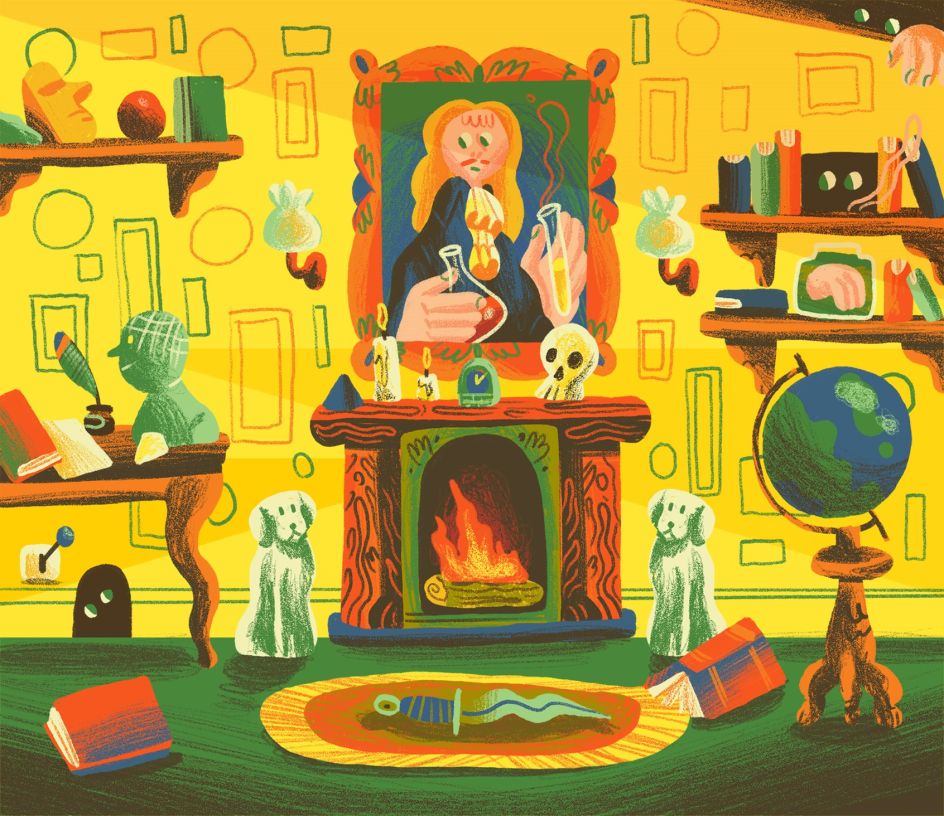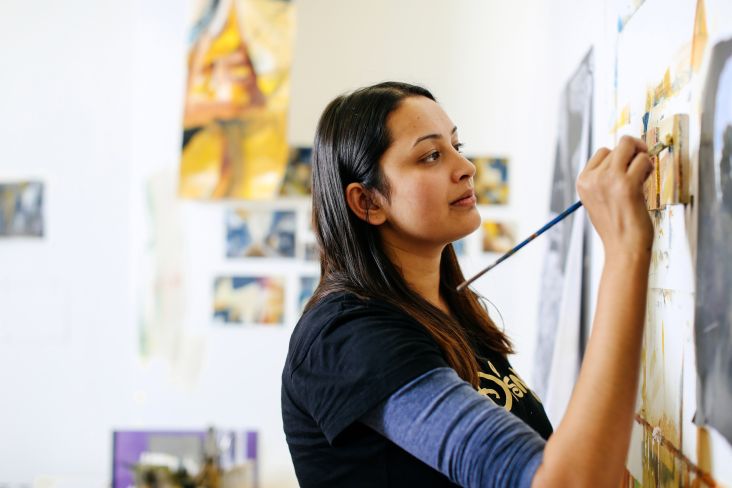Insider tips on how to make it as a professional illustrator
Whether you're thinking of quitting your job and going it alone, or are already a seasoned freelancer, it's always good to get the benefit of other illustrators' experience. After all, some relatively small changes to your habits, workflow or attitude could make a big difference in terms of finding more work and getting paid better. And who wouldn't want that?

Illustration by Hye-Jin Chung
To help you out we've partnered with the Directory of Illustration to bring you this great selection of tips and advice from successful freelance illustrators. (Indeed: here's our first tip: consider signing up to the Directory, which will put you in front of the largest audience of qualified art buyers in the world: check out the details here.)
So read on to discover great advice on boosting your freelance career in 2020, from world-class illustrators including the likes of Lars Madsen, Debi Pickler, Zach Meyer, Jeannie Hart, Michael Arnold, and more.
Find your own voice
There's a lot of organisational and financial stuff that underpins any successful freelance career, and we'll get to that in a moment. But at its most fundamental, freelance success depends on having a service to sell that can't be easily replicated by others. If it can, then you'll be in a race to the bottom regarding pricing, as a quick look at sites like Fiverr will attest. So it's vital to find and develop your illustration style, to help you stand out from the crowd and demand the kind of rates you want to be paid.
David Deen, who creates illustrations for children's books, has spent his freelance career developing a unique personal style and sees it as a win-win. "It keeps the work feeling fresh and lets me play with it, which keeps it fun, which in turn leads to the best result," he explains.
Roll with the punches
However talented and unique you are as an illustrator, there's no guarantee that everything in your career will go your way. So you must learn to roll with the punches and take every knockback in your stride. There'll be times when your work is rejected, there'll be times when the client doesn't understand your vision, and there'll be times when you're short of work. And that's okay, says Steve Hayes, freelance illustrator skilled in advertising, book publishing and greeting cards.
"I have learned over time that I must roll with the ups and downs," says Hayes. "Sometimes I'm busy and sometimes not. I keep my eye on my goals and what I stand for and don't let myself be run by my emotional state and fears when everything isn't going according to my plan."
Adam Niklewicz, who specialises in corporate, book cover and website illustration, agrees, noting that: "You have to develop a substantial tolerance for uncertainty." While Dave Plunkert, whose illustrations have appeared in advertising campaigns for Fortune 500 companies, newspapers, magazines, and record labels, adds that, "If an idea or concept doesn't get approved for a specific project it's not the end of the world or a wasted effort. It will most likely work for something else."

Illustration by Dave Plunkert
Play the long game
Working as a freelance illustrator can be the most financially and creatively rewarding of careers: a combination not offered by many other professions. But to succeed takes time, and so you have to be prepared to work hard, consistently, over several years.
Zach Meyer, whose detailed portraits and narrative works have been published internationally, stresses the importance of persistence. "A lot of young artists get discouraged when they don't hear back from self-promotion, wanting a more immediate reaction to their hard work building a portfolio," he says. "But no artist is discovered without hard work and persistence. It is important to create your own opportunities and share your work with those you are interested in working for.
"Those artists that persist in the face of rejection will make it as illustrators," he continues. "For me, I would get discouraged when my promos wouldn't immediately get a response, but persistence paid off for me in the long run. I kept generating new work and reaching out to people I wanted to work for. And after almost 12 years I'm now an established illustrator."
That doesn't mean, though, that he can rest on his laurels. "Even as an established illustrator with an agent I have to constantly make new work when I have downtime, and send promos and updates to existing clients to continue to get freelance work," he notes.
Michael Arnold, a multi-disciplinary designer and illustrator currently working at The Economist, agrees. "Persistence is on the most important skills to learn," he stresses. "It's never personal when you lose a brief or client enquiry, and it often pays to follow up with that lost job down the line."

Illustration by Yulong Lli
Don't undersell yourself
One of the trickiest things about being a freelance illustrator is setting your pricing. There's no such thing as a standard rate, so you have to put effort, energy and enthusiasm into getting your rates right.
Fine artist, illustrator and designer Jessica Hancock advises that you: "Do your research to make sure your pricing is competitive, but don't feel like you need to match or undercut your competition. Don't be afraid to say no when a client or prospect asks you for a discount, but be prepared to justify your position."
Cartoonist Steve Delmonte suggests you consider not just what you should be paid, but what the company can afford. "Always ask what the client's budget is," he recommends. "A lot of the time it's more than you would ask for. I charge by the use, meaning where will it be used and in what media."
Scott Balmer, who specialises in editorial, advertising and publishing illustration, concurs. "First, I would ask what size the budget is. Sometimes you get an answer and other times they tell you nothing. Make sure that the work rate is fair to both you and the client from both a monetary and wellbeing standpoint. You shouldn't overwork yourself to fit whatever short deadline they give you, thinking that they can cut costs and more likely not getting the best when it comes to the result."
It's not about 'winning' a negotiation as such, but about reaching a rate that will make both you and your client happy. "Be honest and fair," advises fine artist, designer and illustrator Debi Pickler. Everyone needs to feel they have won. I reference past jobs, talk to other freelancers, and Google standard rates for that particular project. Make sure your quote spells out everything you will provide your client, and what your client will receive in return. Have them sign it so that everyone knows their role. Over-communication is best."
"The key things to consider are not only how long it took you to create the piece, but how long the client intends to use it for, and to what effect," adds Michael Arnold." Fees are a sliding scale, and you get better at judging who can afford what only by making mistakes, unfortunately. There's no harm in asking, and it's easier to negotiate down in price than it is to negotiate up."
"Everything is worth what people are willing to pay," says illustrator and animator Lars Madsen. "But I recommend having a reference for pricing like the Graphic Artists Guild Handbook. You will learn the rest from experience. When you laugh a little to yourself when you're charging, you're probably charging right! And never forget that you have practised your whole life to achieve your skills. That's worth a lot!"

Illustration by Zach Meyer
Promote yourself
If you want to be offered more and better-paid work, then you need to be constantly marketing yourself and keeping your name out there, because no one else is going to do it for you. But a random and scattergun approach will get you nowhere, cautions artist and designer Jeannie Hart.
"Consistency is key and having an editorial calendar can help when you are pressed to find content," she says. "It's also beneficial to have the right tools for the channels you are working with. Without tools to find the right hashtags or best times to post for your followers, growth is painfully slow."
As well as consistency of posting and emailing, you need to be putting out a consistent message, says Jessica Hancock. "You are a business, and you should have a clear brand image. So do your best to present yourself consistently and professionally. Be yourself, but be polished about it!
"Take the time to create a cohesive presence on the web - a website, Instagram, Facebook, Twitter, YouTube - then join groups and forums and drive them to your sites as appropriate. Take advantage of free art portfolio sites. Join professional art organisations. Get involved with your local art scene, and if you can afford it, buy into reputable services like Workbook and Directory of Illustration. Network!"
David Plunkert adds: "I enter shows, do podcast interviews when asked, and post new work on Instagram, LinkedIn and Twitter. I maintain online portfolios at directoryofillustration.com and a handful of others. Occasionally I'll do a print mailer, but fewer art directors rely on those. I still think they work, but they have to be interesting and targeted to the right folks."
And if you're short of ideas, steal them! "Find out what other illustrators with your skillset are doing," suggests Debi Pickler. "Mimic their strategies. Then ... do it better! Be proud you are an illustrator. Talk about what you do. Take on projects that highlight your strengths. Don't always accept the 'cheap or no pay' projects to get your name out there or to have that one project in your portfolio. Other professionals don't give away their services. Neither should you."
"You can find clients by going to bookstores and reading mastheads, or by going on Instagram to see who some of your favourite illustrators are working with," suggests Zach Meyer. "A lot of times, art directors are tagged in each post. Sites like Agency Access and Rocket Reach are paid ways of finding companies that use illustration.
"Once your list is made, try a variety of different forms of promotion from postcards, books, emails, and portfolio reviews, and see what works best for you," he adds. "Always make it particular to the client, and approach it as if you're developing a friendship.
"Email promotion also works best if it's personal. Come up with a creative subject line and introduce yourself, providing a link to your website. Vague emails such as "Freelance Illustrator" will get lost and won't be opened. Clients find you through online social media postings, published work, and self-promotion."

Illustration by Scott Balmer
Beat creative block
Meeting deadlines and pleasing clients means making the most productive use of your time. But what can you do when you find yourself staring into the abyss, your head empty of ideas?
"When I run into creative block, I switch from drawing to writing," says Jeannie Hart. "I write out the key points of the brief and then mind map solutions around those key points until lightning strikes."
Scott Balmer, however, takes a different approach. "This might seem counterintuitive but stopping and doing something else usually works," he says. "I find that forcing something to work rarely shows off your best work."
"My best tip for overcoming a creative block is to finish ideas as they come in, even if an idea seems bad," says Zach Meyer. "Sketching it to a finalised idea frees up your brain for more ideas. Also, Googling terms from the brief you are working with can help break down how to communicate an idea with literal images from that term. Lastly, just combining symbols in the story can help to structure your ideas."
Treat illustration like a business
This shouldn't really need spelling out, but it's vital that you treat your profession as a business from day one. "It's amazing to think that there are people who think what you do is more like a hobby and therefore think you will do work for them either at a discount or for nothing at all," says Scott Balmer. "Sure, it may be great that you draw for a living, but if you can't make artwork based on things that don't interest you, then you will be in for a hard time when it comes to putting out your best."
Going freelance means putting a lot of effort into all the administrative and organisational tasks of running a business, which might not be fun in itself, but will enable you to sustain yourself financially. "Make time to keep track of everything," urges Jessica Hancock. "This includes contacts, expenses, receipts, time, etc. It's not exciting, but it's important, especially if you want to scale your business and grow in the most efficient and economical way possible."
"Make sure you have enough financial reserves to weather slow times, last-minute changes by the client, and having to wait for a long time for payment," adds Steve Hayes. "Adapting to not getting that weekly paycheque takes getting used to. You must trust your unique contribution and not try to adapt your style just to try to make it."
And being business-oriented also means doing everything you can, within reason, to please clients. "Be humble, but confident," advises Debi Pickler. "Smile. Your client is hiring YOU because YOU are the expert. So do the best you can. And have fun!! That said, don't ever be married to your projects. Why? Reread question one. If your client wants a polka-dotted, slime green, starburst looking splat over that super cool illustration you just created (even though it looks like garbage), you gotta roll with it. And do it with a smile."










](https://www.creativeboom.com/upload/articles/86/862919952c0ad18439004228895a431dc6e45ffc_732.jpg)












